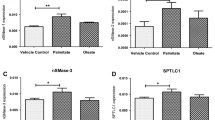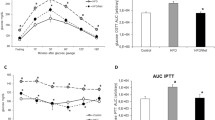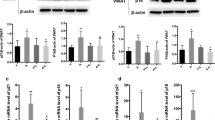Abstract
Sphingolipids play an important role in the development of insulin resistance. Ceramides are the most potent inhibitors of insulin signal transduction. Ceramides are generated in response to stress stimuli and in old age. In this work, we studied the possible contribution of different pathways of sphingolipid metabolism in age-dependent insulin resistance development in liver cells. Inhibition of key enzymes of sphingolipid synthesis (serine palmitoyl transferase, ceramide synthase) and degradation (neutral and acidic SMases) by means of specific inhibitors (myriocin, fumonisin B1, imipramine, and GW4869) was followed with the reduction of ceramide level and partly improved insulin regulation of glucose metabolism in “old” hepatocytes. Imipramine and GW4869 decreased significantly the acidic and neutral SMase activities, respectively. Treatment of “old” cells with myriocin or fumonisin B1 reduced the elevated in old age ceramide and SM synthesis. Ceramide and SM levels and glucose metabolism regulation by insulin could be improved with concerted action of all tested inhibitors of sphingolipid turnover on hepatocytes. The data demonstrate that not only newly synthesized ceramide and SM but also neutral and acidic SMase-dependent ceramide accumulation plays an important role in development of agedependent insulin resistance.
Similar content being viewed by others
Abbreviations
- Akt/PKB:
-
protein kinase B
- GLUT:
-
glucose transporter
- IL:
-
interleukin
- mTOR:
-
mammalian target of rapamycin
- PKC:
-
protein kinase C
- PLD:
-
phospholipase D
- SM:
-
sphingomyelin
- SMase:
-
sphingomyelinase
- SPT:
-
serine palmitoyl CoA transferase
- TNF-α:
-
tumor necrosis factor α
References
Holland, W. L., and Summers, S. A. (2008) Sphingolipids, insulin resistance, and metabolic disease: new insights from in vivo manipulation of sphingolipid metabolism, Endocrine Rev., 29, 381–402.
Babenko, N. A. (2011) in Saturated Fats: Metabolism, Disease Risks and Public Awareness (Langella, J. P., ed.) Nova Science Publishers, New York, pp. 71–97.
Stratford, S., DeWald, D. B., and Summers, S. A. (2001) Ceramide dissociates 3′-phosphoinositide production from pleckstrin homology domain translocation, Biochem. J., 354, 359–368.
Ugi, S., Imamura, T., Maegawa, H., Egawa, K., Yoshizaki, T., Shi, K., Obata, T., Ebina, Y., Kashiwagi, A., and Olefsky, J. M. (2004) Protein phosphatase 2A negatively regulates insulin’s metabolic signaling pathway by inhibiting Akt (protein kinase B) activity in 3T3-L1 adipocytes, Mol. Cell. Biol., 24, 8778–8789.
Babenko, N. A., and Kharchenko, V. S. (2012) Ceramides inhibit phospholipase D-dependent insulin signaling in liver cells of old rats, Biochemistry (Moscow), 77, 180–186.
Pileggi, A., Fenjves, E. S., Klein, D., Ricordi, C., and Pastori, R. L. (2004) Protecting pancreatic beta-cells, IUBMB Life, 56, 387–394.
Zhao, H., Przybylska, M., Wu, I. H., Zhang, J., Siegel, C., Komarnitsky, S., Yew, N. S., and Cheng, S. H. (2007) Inhibiting glycosphingolipid synthesis improves glycemic control and insulin sensitivity in animal models of type 2 diabetes, Diabetes, 56, 1210–1218.
Adams, 2nd, J. M., Pratipanawatr, T., Berria, R., Wang, E., DeFronzo, R. A., Sullards, M. C., and Mandarino, L. J. (2004) Ceramide content is increased in skeletal muscle from obese insulin-resistant humans, Diabetes, 53, 25–31.
Yamashita, T., Hashiramoto, A., Haluzik, M., Mizukami, H., Beck, S., Norton, A., Kono, M., Tsuji, S., Daniotti, J. L., Werth, N., Sandhoff, R., Sandhoff, K., and Proia, R. L. (2003) Enhanced insulin sensitivity in mice lacking ganglioside GM3, Proc. Natl. Acad. Sci. USA, 100, 3445–3449.
Li, Zh., Zhang, H., Liu, J., Liang, Ch.-P., Li, Ya., Li, Yu., Teitelman, G., Beyer, Th., Bui, H. H., Peake, D., Zhang, Y., Sanders, Ph., Kuo, M.-Sh., Park, T.-S., Cao, G., and Jiang, X.-Ch. (2011) Reducing plasma membrane sphingomyelin increases insulin sensitivity, Mol. Cell. Biol., 31, 4205–4218.
Kralik, S. F., Liu, P., Leffler, B. J., and Elmendorf, J. S. (2002) Ceramide and glucosamine antagonism of alternate signaling pathways regulating insulin- and osmotic shock-induced glucose transporter 4 translocation, Endocrinology, 143, 37–46.
Skovbro, M., Baranowski, M., Skov-Jensen, C., Flint, A., Dela, F., Gorski, J., and Helge, J. W. (2008) Human skeletal muscle ceramide content is not a major factor in muscle insulin sensitivity, Diabetologia, 51, 1253–1260.
Zeghari, N., Younsi, M., Meyer, L., Donner, M., Drouin, P., and Ziegler, O. (2000) Adipocyte and erythrocyte plasma membrane phospholipid composition and hyperinsulinemia: a study in nondiabetic and diabetic obese women, Int. J. Obes. Relat. Metab. Disord., 24, 1600–1607.
Mitsutake, S., Zama, K., Yokota, H., Yoshida, T., Tanaka, M., Mitsui, M., Ikawa, M., Okabe, M., Tanaka, Y., Yamashita, T., Takemoto, H., Okazaki, T., Watanabe, K., and Igarashi, Y. (2011) Dynamic modification of sphingomyelin in lipid microdomains controls development of obesity, fatty liver, and type 2 diabetes, J. Biol. Chem., 286, 28544–28555.
Petrenko, A. Yu., Sukach, A. N., and Roslyakov, A. D. (1991) Isolation of rat hepatocytes by a nonenzymatic method: detoxification and respiratory activities, Biochemistry (Moscow), 56, 1160–1162.
Brutman-Barazani, T., Horovitz-Fried, M., Aga-Mizrahi, Sh., Brand, Ch., Brodie, Ch., Rosa, J., and Sampson, S. R. (2012) Protein kinase Cδ but not PKCα is involved in insulin-induced glucose metabolism in hepatocytes, J. Cell. Biochem., 113, 2064–2076.
Bligh, E. G., and Dyer, W. J. (1959) A rapid method of total lipid extraction and purification, Can. J. Biochem. Physiol., 37, 911–917.
Wadsworth, J. M., Clarke, D. J., McMahon, S. A., Lowther, J. P., Beattie, A. E., Langridge-Smith, P. R., Broughton, H. B., Dunn, T. M., Naismith, J. H., and Campopiano, D. J. (2013) The chemical basis of serine palmitoyl transferase inhibition by myriocin, J. Am. Chem. Soc., 135, 14276–14285.
Wang, E., Norred, W. P., Bacon, C. W., Riley, R. T., and Merrill, A. H., Jr. (1991) Inhibition of sphingolipid biosynthesis by fumonisins. Implications for diseases associated with Fusarium moniliforme, J. Biol. Chem., 266, 14486–14490.
Babenko, N. A., Hassouneh, L. Kh. M., Kharchenko, V. S., and Garkavenko, V. V. (2012) Vitamin E prevents the age-dependent and palmitate-induced disturbances of sphingolipid turnover in liver cells, Age (Dordr.), 34, 905–915.
Kornhuber, J., Tripal, Ph., Reichel, M., Muhle, C., Rhein, C., Muehlbacher, M., Groemer, T. W., and Gulbins, E. (2010) Functional inhibitors of acid sphingomyelinase (FIASMAs): a novel pharmacological group of drugs with broad clinical applications, Cell Physiol. Biochem., 26, 9–20.
Luberto, C., Hassler, D. F., Signorelli, P., Okamoto, Y., Sawai, H., Boros, E., Hazen-Martin, D. J., Obeid, L. M., Hannun, Y. A., and Smith, G. K. (2002) Inhibition of tumor necrosis factor-induced cell death in MCF7 by a novel inhibitor of neutral sphingomyelinase, J. Biol. Chem., 277, 41128–41139.
Leclercq, I. A., Morais, A. D. S., Schroyen, B., Van Hul, N., and Geerts, A. (2007) Insulin resistance in hepatocytes and sinusoidal liver cell: mechanisms and consequences, J. Hepatol., 47, 142–156.
Dodson, M. M., Kulkarni, R. N., Postic, K., Previs, S. F., Shulman, G. I., Magnuson, M. A., and Khan, R. C. (2000) Loss of insulin signaling in hepatocytes leads to severe insulin resistance and progressive hepatic dysfunction, Mol. Cell, 6, 87–97.
Le Couteur, D. G., Everitt, A., and Lebel, M. (2009) The aging liver, Geriatr. Aging, 12, 319–322.
Babenko, N. A., and Semenova, Ya. A. (2010) Effects of long-term fish oil-enriched diet on the sphingolipid metabolism in brain of old rats, Exp. Gerontol., 45, 375–380.
Babenko, N. A., and Shakhova, E. G. (2014) Long-term food restriction prevents aging-associated sphingolipid turnover dysregulation in the brain, Arch. Gerontol. Geriatr., 58, 420–426.
Lightle, S. A., Oakley, J. I., and Nikolova-Karakashian, M. N. (2000) Activation of sphingolipid turnover and chronic generation of ceramide and sphingosine in liver during aging, Mech. Ageing Dev., 120, 111–125.
Larsen, P. J., and Tennagels, N. (2014) On ceramides, other sphingolipids and impaired glucose homeostasis, Mol. Metab., 28, 252–260.
Galbo, T., and Shulman, G. I. (2013) Lipid induced hepatic insulin resistance, Aging, 5, 582–583.
Holland, W. L., Brozinick, J. T., Wang, L.-P., Hawkins, E. D., Sargent, K. M., Liu, Y., Narra, K., Hoehn, K. L., Knotts, T. A., Siesky, A., Nelson, D. H., Karathanasis, S. K., Fontenot, G. K., Birnbaum, M. J., and Summers, S. A. (2007) Inhibition of ceramide synthesis ameliorates glucocorticoid-, saturated-fat-, and obesity-induced insulin resistance, Cell Metab., 5, 167–179.
Yang, G., Badeanlou, L., Bielawski, J., Roberts, A. J., and Hannun, Y. A. (2009) Central role of ceramide biosynthesis in body weight regulation, energy metabolism, and the metabolic syndrome, Am. J. Physiol. Endocrinol. Metab., 297, E211–E224.
Ussher, J. R., Koves, T. R., Cadete, V. J. J., Zhang, L., Jaswal, J. S., Swyrd, S. J., Lopaschuk, D. G., Proctor, S. D., Keung, W., Muoio, D. M., and Lopaschuk, G. D. (2010) Inhibition of de novo ceramide synthesis reverses diet-induced insulin resistance and enhances whole-body oxygen consumption, Diabetes, 59, 2453–2464.
Chavez, J. A., Knotts, T. A., Wang, L.-P., Li, G., Dobrowsky, R. T., Florant, G. L., and Summers, S. A. (2003) A role for ceramide, but not diacylglycerol, in the antagonism of insulin signal transduction by saturated fatty acids, J. Biol. Chem., 278, 10297–10303.
Powell, D. J., Turban, S., Gray, A., Hajduch, E., and Hundal, H. S. (2004) Intracellular ceramide synthesis and protein kinase Czeta activation play an essential role in palmitate-induced insulin resistance in rat L6 skeletal muscle cells, Biochem. J., 382, 619–629.
Watson, M. L., Coghlan, M., and Hundal, H. S. (2009) Modulating serine palmitoyl transferase (SPT) expression and activity unveils a crucial role in lipid-induced insulin resistance in rat skeletal muscle cells, Biochem. J., 417, 791–801.
Teruel, T., Hernandez, R., and Lorenzo, M. (2001) Ceramide mediates insulin resistance by tumor necrosis factor-alpha in brown adipocytes by maintaining Akt in an inactive dephosphorylated state, Diabetes, 50, 2563–2571.
Peraldi, P., Hotamisligil, G. S., Buurman, W. A., White, M. F., and Spiegelman, B. M. (1996) Tumor necrosis factor (TNF)-alpha inhibits insulin signaling through stimulation of the p55 TNF receptor and activation of sphingomyelinase, J. Biol. Chem., 271, 13018–13022.
Kanety, H., Hemi, R., Papa, M. Z., and Karasik, A. (1996) Sphingomyelinase and ceramide suppress insulin-induced tyrosine phosphorylation of the insulin receptor substrate-1, J. Biol. Chem., 271, 9895–9897.
Begum, N., and Ragolia, L. (1996) Effect of tumor necrosis factor-alpha on insulin action in cultured rat skeletal muscle cells, Endocrinology, 137, 2441–2446.
Van Sluijters, D. A., van Woerkom, G. M., Aerts, J. M. F. G., and Meijer, A. J. (1999) Sphingomyelinase treatment of rat hepatocytes inhibits cell-swelling-stimulated glycogen synthesis by causing cell shrinkage, Eur. J. Biochem., 266, 653–659.
Rutkute, K., Karakashian, A. A., Giltiay, N. V., Dobierzewska, A., and Nikolova-Karakashian, M. N. (2007) Aging in rat causes hepatic hyperresponsiveness to interleukin-1beta which is mediated by neutral sphingomyelinase-2, Hepatology, 46, 1166–1176.
Lagathu, C., Yvan-Charvet, L., Bastard, J. P., Maachi, M., Quignard-Boulange, A., Capeau, J., and Caron, M. (2006) Long-term treatment with interleukin-1beta induces insulin resistance in murine and human adipocytes, Diabetologia, 49, 2162–2173.
Bruunsgaar, H. (2002) Effects of tumor necrosis factoralpha and interleukin-6 in elderly populations, Eur. Cytokine Netw., 13, 389–391.
Rikans, L. E., DeCicco, L. A., Hornbrook, K. R., and Yamano, T. (1999) Effect of age and carbon tetrachloride on cytokine concentrations in rat liver, Mech. Ageing Dev., 108, 173–182.
Kirwan, J. P., Krishnan, R. K., Weaver, J. A., Del Aguila, L. F., and Evans, W. J. (2001) Human aging is associated with altered TNF-alpha production during hyperglycemia and hyperinsulinemia, Am. J. Physiol. Endocrinol. Metab., 281, E1137–E1143.
Bruce, C. R., and Dyck, D. J. (2004) Cytokine regulation of skeletal muscle fatty acid metabolism: effect of interleukin-6 and tumor necrosis factor-alpha, Am. J. Physiol. Endocrinol. Metab., 287, E616–E621.
Steinberg, G. R., Michell, B. J., van Denderen, B. J., Watt, M. J., Carey, A. L., Fam, B. C., Andrikopoulos, S., Proietto, J., Gorgun, C. Z., Carling, D., Hotamisligil, G. S., Febbraio, M. A., Kay, T. W., and Kemp, B. E. (2006) Tumor necrosis factor alpha-induced skeletal muscle insulin resistance involves suppression of AMP-kinase signaling, Cell Metab., 4, 465–474.
Dyck, D. J., Heigenhauser, G. J., and Bruce, C. R. (2006) The role of adipokines as regulators of skeletal muscle fatty acid metabolism and insulin sensitivity, Acta Physiol. (Oxf.), 186, 5–16.
Nov, O., Kohl, A., Lewis, E. C., Bashan, N., Dvir, I., Ben-Shlomo, S., Fishman, S., Wueest, S., Konrad, D., and Rudich, A. (2010) Interleukin-1beta may mediate insulin resistance in liver-derived cells in response to adipocyte inflammation, Endocrinology, 151, 4247–4256.
Dobierzewska, A., Shi, L., Karakashian, A. A., and Nikolova-Karakashian, M. N. (2012) Interleukin 1β regulation of FoxO1 protein content and localization: evidence for novel ceramide-dependent mechanism, J. Biol. Chem., 287, 44749–44760.
Ugi, S., Imamura, T., Maegawa, H., Egawa, K., Yoshizaki, T., Shi, K., Obata, T., Ebina, Y., Kashiwagi, A., and Olefsky, J. M. (2004) Protein phosphatase 2A negatively regulates insulin’s metabolic signaling pathway by inhibiting Akt (protein kinase B) activity in 3T3-L1 adipocytes, Mol. Cell Biol., 24, 8778–8789.
Author information
Authors and Affiliations
Corresponding author
Additional information
Original Russian Text © N. A. Babenko, V. S. Kharchenko, 2015, published in Biokhimiya, 2015, Vol. 80, No. 1, pp. 132–141.
Rights and permissions
About this article
Cite this article
Babenko, N.A., Kharchenko, V.S. Effects of inhibitors of key enzymes of sphingolipid metabolism on insulin-induced glucose uptake and glycogen synthesis in liver cells of old rats. Biochemistry Moscow 80, 104–112 (2015). https://doi.org/10.1134/S0006297915010125
Received:
Revised:
Published:
Issue Date:
DOI: https://doi.org/10.1134/S0006297915010125




